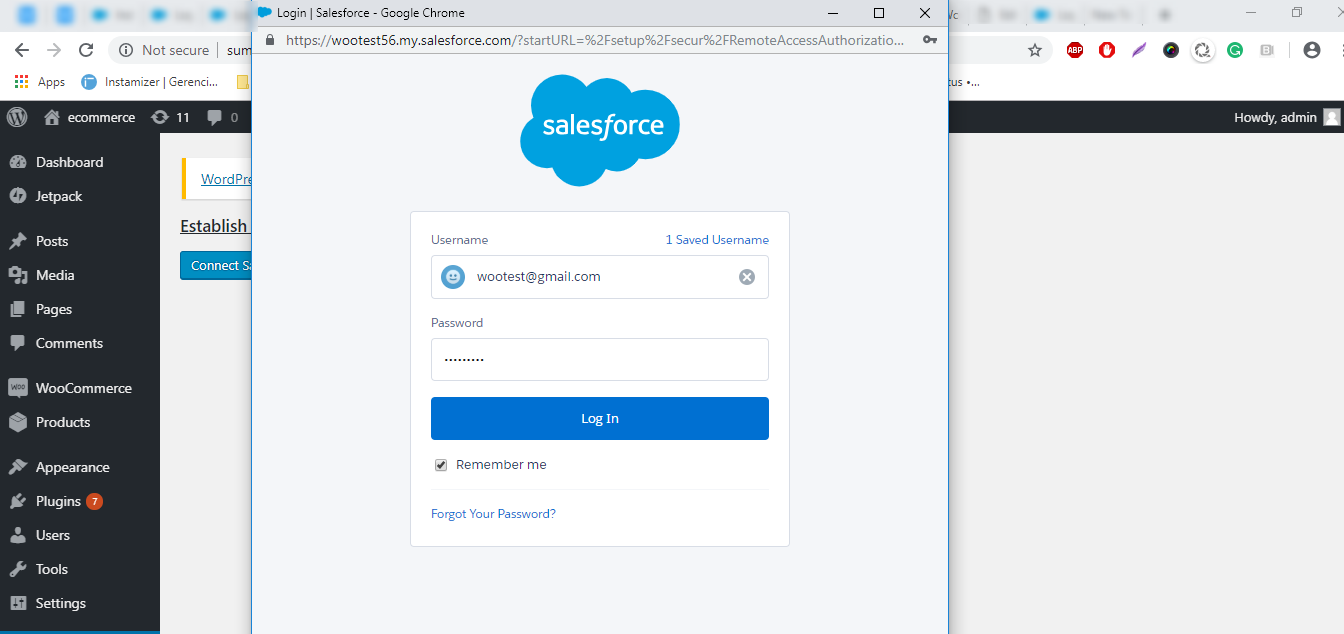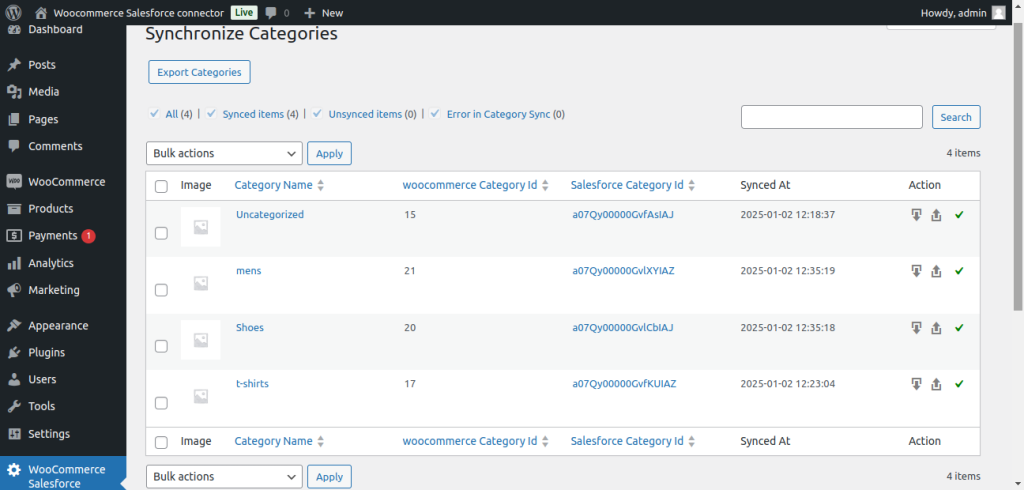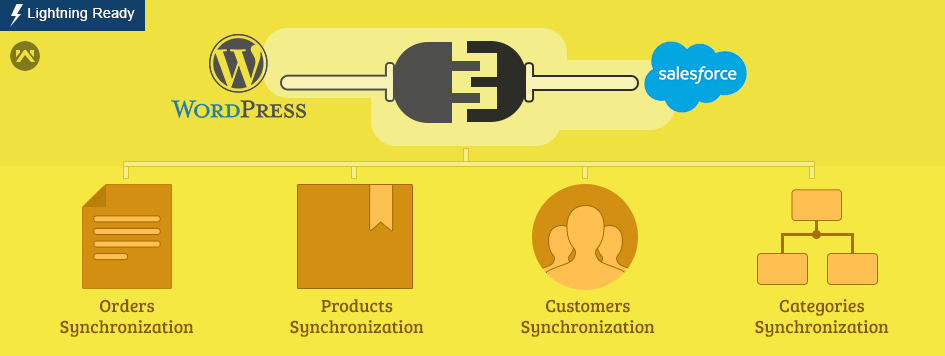WordPress WooCommerce Salesforce Connector and Integration
This magnificent WordPress WooCommerce Salesforce Integration and Connector integrates between WooCommerce and the Salesforce platform.
It is the next-generation extension enhancing the features of e-commerce and CRM.
WooCommerce content can sync with Salesforce to give a brand new picture to the concept of B2B and B2C deals, and synchronization of Users.
The idea behind the concept is to increase data integrity, maintain proper inventory of stock, real-time order generation, provide brilliant customer care services, and much more.
Features:
- It gives the concept of a ‘Service-first’ approach.
- Acts as a bridge between WooCommerce and Salesforce.
- The synchronization process will run in the background when you export the records.
- Lightning features support and provide you with an interactive design.
- Can process bulk data synchronization from WooCommerce to Salesforce.
- Map WooCommerce Order Status to Salesforce Order Status and/or Opportunity stages.
- You get an option to check the Custom error and success message logging while importing or exporting objects.
- Provided a feature to Synchronize individual Tax rates to Salesforce fields when syncing orders from Woocommerce to Salesforce.
- Option to Synchronize WooCommerce users as Business or Person accounts in Salesforce.
- Dynamic field mapping is provided for users, products, and Orders, you can add/remove field mappings as per your need.
- Enable or disable Real-Time synchronization of users, products, categories, and orders from WooCommerce to Salesforce.
- Manual synchronization of WooCommerce Users, Products, Categories, and Orders to Salesforce is also provided.
- Users can navigate to Salesforce by clicking on the Salesforce IDs from the WordPress WooCommerce Salesforce Connector end.
- Synchronize the Product/Category image in Notes and attachments or folders to Salesforce.
- Synchronize product prices to the selected Price book of Salesforce.
- Only Synchronization of Simple products from WooCommerce site to Salesforce.
- Fully based on REST API using OAuth2.0 of Salesforce to provide an easy, fast, and secure setup for the user.
Note: The specific customizations of syncing data from Salesforce to WooCommerce and real-time data synchronization can be implemented in a bi-directional way.
Product variation synchronization is possible as per your business requirements. This would be a paid feature. To enable this bi-directional feature, kindly contact our support team.
For more details about Plans with features & Pricing
Pre-Configuration settings
Once you install “eShopSync For WooCommerce” from AppExchange. Go through the links mentioned below to update the required settings.
Update Field Accessibility: Learn to update field accessibility
If you want to avail Salesforce Lightning experience, you need to register your domain first.
Domain Registration: How to Register Domain in Salesforce
How to Connect :
WooCommerce Salesforce Connector Configuration:
Install The WooCommerce Salesforce Connector Plugin
Go to Plugins | Add new as shown below in the snapshot.

Then click on the Upload Plugin button.

Now, upload the zip file of the WordPress WooCommerce Salesforce connector.

When the package installation is done. Go to the Plugin option and Activate the connector.

Establish A Connection Of WooCommerce With Salesforce
The steps to establish a connection are mentioned below with snapshots. follow the process carefully:
1. When installed and activate the plugin will show on the left navigational panel.
2. Click on the desired button to connect it with your Salesforce Org.

3. You do not need to enter the Salesforce Org Credentials. It would fetch from the browser.

4. In the Connection Settings tab, users can refresh the connection, disconnect the account & reset the mapping, and delete the logs from these tabs.

5. Go to the Category and Product tab, configure the toggles as required, and then click on the Save button to save the settings.


6. In the Account and Contact tab, configure the toggles as required and then click on the Save button to save the settings.

7. Click on the Order and Opportunity tab, configure the toggles as required and then click on the Save button to save the settings.

8. Open the Advanced Settings tab, and go to the Account option tab. Then match the fields as per the data entry you want.
It must contain at least one mapped field. After that, click on the Save button to save the settings.

9. In the Advanced Settings tab, click on the Contact option. Then match the fields as per the data entry you want.
It must contain at least one mapped field. After that, click on the Save button to save the settings.

10. In the Advanced Settings tab, click on the Product option. Then match the fields as per the data entry you want.
It must contain at least one mapped field. After that, click on the Save button to save the settings.

You can set Matching Criteria to prevent duplicate records to be created in Salesforce.
You can match the records from both platforms based on different fields and the records will only sync if the values in these fields match.
For example- If the matching criteria are set with the Email field, if the email field matches the records on both platforms, it will sync those records.
If the email field value is different, it will create a new record in Salesforce.
View Of Entities At Salesforce And WordPress WooCommerce End
Products
View of Products List View in WordPress WooCommerce Salesforce Connector

Users
View of Users List View in WordPress WooCommerce Salesforce Connector

Orders
View of Orders List View in WordPress WooCommerce Salesforce Connector

Categories
View of Categories List View in WordPress WooCommerce Salesforce Connector

Field Mapping At WordPress WooCommerce Salesforce End:
Account & Contact Field Mapping
For the Custom field Mapping, users have to map the meta fields of WooCommerce with the salesforce custom fields.
Also, activate users would able to get at the specific fields information at the salesforce end once it was synchronized.




Similarly, you can proceed with the Product and order field mapping.
Product Field Mapping:



Order & Opportunity Field Mapping:


Click here to Map the WooCommerce Order Status to the Salesforce Order Status



Click here to Map the WooCommerce Opportunity Status to the Salesforce Opportunity Status

Frequently Asked Questions:
Question: What is the best way to test the purchased connector file?
Answer: Data integrity is the main area of concern, we would recommend installing and testing the connector sync features in the Development site.
First, by establishing the connection with Salesforce Sandbox. Upon successful testing, you may proceed to install the connector in the Live site and Salesforce Production environment.
Question: What are the benefits of purchasing the connector along with Installation fees?
Answer: Purchasing a connector along with Installation fees, just brings you into a comfort zone where you just need to share the required details to initiate the installation process.
Our concerned team will effectively proceed with the installation process as soon we get complete details.
Your trust and satisfaction are highly important to us so your data will be completely secured.
Question: What will be covered by Installation fees?
Answer: We will install and set up Connector at the WooCommerce end and get things ready to go situation for you.
Installation of eShopSync For WooCommerce as well, in case it is not installed at the Salesforce end.
We will sync a test record on each object to make sure that synchronization is working fine. Further, you may proceed with synchronization on your own.
Question: What are the required details mandatory to share for the Installation procedure?
Answer: You need to share the following details to proceed with the installation and setup of the connector:
- Would be preferable to install it in the Development site first in connection with Salesforce Sandbox, so create a Dev site and share the details accordingly.
- WooCommerce Admin URL of the concerned site with login credentials.
- Salesforce login credentials
- SFTP/FTP Details such as Host Name, Port, User, and Password.
NOTE: Mandatory to share SFTP/FTP details and all of the concerned sites such as Host Name, Port, User, and Password if we experience any issue while connector installation due to any plugin conflict.
Question: What are the conditions to pay Installation fees?
Answer: If you are stuck and having trouble while proceeding with configuration then you need to pay Installation fees along with the required details to install and set up the connector properly.
To pay the Installation fees: Click Here
NOTE: We have already provided helpful links and video tutorials to install and set up the connector.
Question: When you can avail benefits of free support?
Answer: Free support comes into the picture once the connector is installed and configured properly.
If there is any issue during the connector installation then it will fall under the Installation process and will be treated as per the Installation procedure.
In case, you have not paid the installation fees and want support to install and configure the connector.
Then, you need to pay the installation fees and must share the required details to initiate the Connector installation procedure.
Question: What will be covered under the Free 3 months of support availed with connector purchase?
Answer: Post successful connector installation and configuration, if you are experiencing any issue while data synchronization that would fall under free support.
You may find steps to resolve the issue under the Frequently Asked Questions section as per the error received.
Else, you may create a ticket on the link mentioned under the Support section with steps to reproduce and provide all required login details.
Question: What are the details mandatory to be shared to debug the issue?
Answer: You need to share the following details to investigate the issue:
- WooCommerce Admin URL of the concerned site with login credentials.
- SFTP/FTP Details such as Host Name, Port, Username, and Password.
- Salesforce login credentials. Or, you may grant login access for Salesforce as well: How to Grant Login Access
NOTE: Mandatory to share SFTP/FTP details and all of the concerned sites such as Host Name, Port, User, and Password if required while investigating.
Question: What if you can’t share SFTP/FTP details or Login credentials of WooCommerce and Salesforce due to privacy/security concerns?
Answer: Your data is highly secured with us and it is mandatory to share SFTP/FTP details and login credentials of WooCommerce and Salesforce while investigating any issue.
Without having complete details, we can’t proceed any further.
Question: Can you provide support on screen sharing sessions via any medium like Team Viewer/ GoToMeeting/Etc.?
Answer: No, we don’t provide any support on any of the screen-sharing sessions like Team Viewer/GoToMeeting/etc. Hence, it is mandatory to share complete details to provide seamless support.
Question: What if you can’t share the asked details on the support ticket to debug the issue and want a full refund?
Answer: In this case, the refund will be processed as per the Refund Policy: Check Refund Policy Here
Questions: What are the other options to get support if you have privacy concerns sharing Live Site details?
Answer: You need to provide a development environment (complete replica of the Live site) with the following details:
- Steps to reproduce
- Login credentials
- SFTP/FTP details such as Host Name. Port, User, and Password
We will debug the issue and provide a proper resolution on the Development site. Upon successful testing, you can implement it on the Live site.
Question: Error FIELD_INTEGRITY_EXCEPTION: There’s a problem with this country, even though it may appear correct. Please select a country/territory from the list of valid countries.
Answer: It seems that you have to “enable” the feature of State and Country/Territory Picklists in your Salesforce Org.
WooCommerce Salesforce Connector doesn’t support the sync feature with this enabled feature.
You need to disable* State and Country/Territory Picklist in Salesforce by the following path Go To Setup | Data Management | State and Country/Territory Picklist | Click Disable | Save it.
Then try to sync the user and it should be working fine.
- *NOTE: Make sure to get confirmation from your Salesforce team prior to disabling this State and Country/Territory Picklists feature. It might be used internally in your Salesforce processes.
- You can raise customization requests for WooCommerce Salesforce Connector to sync data with the State and Country/Territory Picklists feature enabled.
- You need to share your custom requirements on the link mentioned under the Support tab below.
Question: Error FIELD_INTEGRITY_EXCEPTION: field integrity exception: AccountId, ContractId (Make sure the order’s account and the contract’s account are the same.)
Possible reason: While changing Sync settings from “ Sync all contacts to Single Account” to “Sync All Contact to Individual Account”.
Answer: Once you change the sync type and save it. This issue will only impact Registered users stored in the WooCommerce accounts. Then, follow the steps to resolve the error.
1. Sync Users first once you update the Syncing type as desired.
2. Only Delete the ” WooCommerce ” account from Salesforce that was previously mentioned to sync all contacts in a Single account.
Deleting a WooCommerce account will automatically delete Orders and related contracts. There is no need to make any changes to the Guest User Account as it will remain with the same functionality.
Once you delete the ” WooCommerce” account, it automatically removes all the Orders and Contracts linked to this account.
Then, Sync Orders will sync all the orders in the corresponding account normally. This will fix the issue completely.
Question: Error API_DISABLED_FOR_ORG: API is not enabled for this Organization or Partner.
Answer: You need to enable API in your Salesforce Org. For the Enterprise edition & up, you get the “API enable” by default.
To verify follow the steps: From Setup | Users | Profiles | Choose the specific Profile of the User | Scroll down to Administrative Permissions
Check mark API Enable” option: https://qsnapnet.com/snaps/76f7fwl3rk65hfr
Note: For Professional Edition, you have to get Professional Edition (with the “API enable” option) to avail of connector Sync features.
Question: Error INVALID_FIELD_FOR_INSERT_UPDATE: Object Name: bad field names on insert/update call: Field Name
Answer: From Setup | Customize | Object | Fields | Click on the Concerned field | Click View Field Accessibility|
Click on the Hidden on the concerned Profile https://qsnapnet.com/snaps/m91ozam0w0l766r | Mark it visible: https://qsnapnet.com/snaps/ip727wbwwxcu9pb and click Save.
Follow this step for all the fields with the concerned object thrown in error.
Question: Error while installing eShopSync For WooCommerce: (Order.Woo_Order_Status__c) Entity not available. The Entity ‘Order’ was not found. Contact the vendor for more details.
Answer: Follow the below path to enable Orders in order to avoid this error
Go to Setup | Customize | Order | Order Settings | Checkmark ” Enable Orders ” then Save
Once you enable Orders, try to install eShopSync For WooCommerce and it will install successfully.
Question: How many Salesforce User is allocated eShopSync For the WooCommerce module license?
Answer: By default, the allocation of a module license per Org is only 1 Salesforce User.
An additional module license is chargeable. Feel free to contact us to get more licenses (One-time payment only).
Question: Error : webkul_wws: Too many query rows: 50001
Answer: Check the existing version of eShopSync For WooCommerce, it should be 1.13 and up.
You may verify the installed version by the following path: Setup| In the quick find, Search for Installed Packages and Select it | Check eShopSync For WooCommerce: Version Number
If it is below 1.13.0 then Click here to Upgrade eShopSync For WooCommerce
After installation, follow the steps mentioned below to make some required changes:
- Go to eShopSync For WooCommerce from the App Menu drop-down | Click on the Customers section | Copy the web link from the address bar to force.com | Paste this link in the Remote site settings section guided in 2 steps.
- Go to Setup | In quick find, search for Remote Site settings and select it | Click New Remote site | Enter details as guided here: https://qsnapnet.com/snaps/yz23zeza9vzvkj4
Now, proceed WooCommerce-Salesforce Connector tab and verify the records. It should be working fine.
Question: Document Error: No document folders are selected in the options.
Answer: Make sure that you have selected a folder in WWS Connector | Settings | Choose Document Folder. Select a folder to store category and product images in Salesforce.
Question: While Clicking on Orders under the WooCommerce Salesforce Connector tab getting the error: Attempt to de-reference a null object.
Answer: Field Level permission is missing in the Order field. Follow the path to update accessibility.
Go to Setup | Customize | Orders | Fields | Click PO Number | Click Set Field-Level Security | Check Mark Visible for desired Profiles | Click Save
Now, go to the Orders section and it should be working fine.
Support
- For any further query, Click To Create Ticket
- To know the feasibility of specific requirements: Request For Customization
- To view all our applications in Appexchange, go to Webkul Appexchange Apps





Leave a Comment
Comments (0)